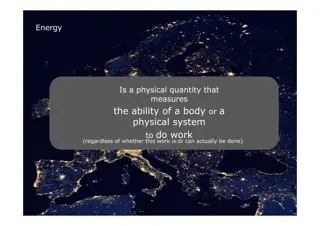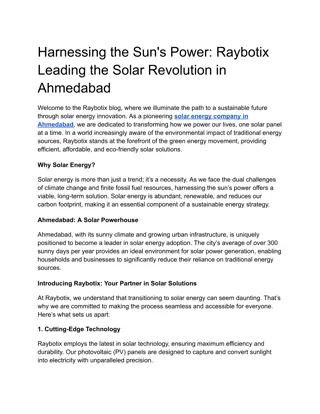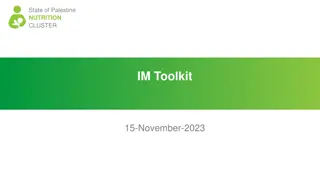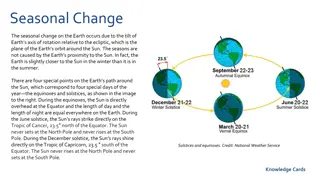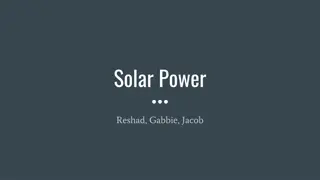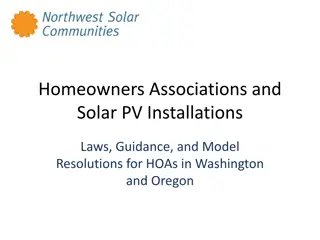Utilizing Solar Energy for Sustainability in Palestine
Exploring the potential of solar energy in Palestine due to the country's high solar radiation levels, limited energy resources, and rising petroleum prices. The introduction covers the uses of solar energy, types of solar collectors, and their efficiencies in generating electricity and heating water. It also explains why solar energy can be a viable solution in Palestine.
Download Presentation

Please find below an Image/Link to download the presentation.
The content on the website is provided AS IS for your information and personal use only. It may not be sold, licensed, or shared on other websites without obtaining consent from the author.If you encounter any issues during the download, it is possible that the publisher has removed the file from their server.
You are allowed to download the files provided on this website for personal or commercial use, subject to the condition that they are used lawfully. All files are the property of their respective owners.
The content on the website is provided AS IS for your information and personal use only. It may not be sold, licensed, or shared on other websites without obtaining consent from the author.
E N D
Presentation Transcript
Submitted To: Dr. Bashir Nouri Prepared By: Abdullah Muhammad Bsharat Ra`ef Muhammad Bsharat FarisAhmad Hantoli
Introduction Uses Of Solar Energy Generating Electricity Solar water heater
Introduction Why solar energy can be used in Palestine ? Palestine 1. Palestine from the country that have great value of solar radiation (5.4 KWH/m2/day). days.(according to NASA studies). 2. Average cloudy days in the year about 20-25 3. Energy resources are either dwindling or non-existent. 4. Increase petroleum fuel unit price recently World Solar Insolation Map
Flat Plate and Evacuated Tube solar collectors
Flat Plate and Evacuated Tube Solar Collectors Evacuated Tube Solar Collectors Flat Plate Solar Collectors
Flat Plate and Evacuated Tube Solar Collectors Evacuated Tube Types 1. Glass to Glass Type 2. Glass to Metal Type a. Evacuated tube with heating pipe. b. Evacuated tube with direct flow.
Flat Plate and Evacuated Tube Solar Collectors Efficiency of Flat plate and Evacuated Tube collectors Heat collected by solar collectors equal to energy absorbed by the absorber minus the heat loss from the surface directly and indirectly to the surrounding. QC= Q absorbed Q loss QC= A[ IC*( )e UC(Tin Ta)] Where ( )e: effective product of transmissivity of the transparent cover and absorptivity of absorber.
Flat Plate and Evacuated Tube Solar Collectors By introducing heat removal factor in the equation is will be as following: QC= A[ IC*FR( )e FRUC(Tin Ta)] The efficiency of solar collector is defined as the ratio of heat output of the collector to solar energy flux incident on the collector. Q * = c c A I c T T ( ) = in a F F U c R R c e I c
Flat Plate and Evacuated Tube Solar Collectors The Following figure show the efficiency curve for three different type collectors: 0.9 Parabolic trough concentrator 0.8 0.7 Evacuated tube Collector efficiency 0.6 0.5 0.4 0.3 0.2 Flat plate collector 0.1 0 0 0.04 0.08 0.12 0.16 0.2 Ti Ta Ic
Flat Plate and Evacuated Tube Solar Collectors According to Nablus City condition the efficiency of Flat plate and evacuated tube collectors presented in following curves. 0.565 Evacuated tube 0.56 0.555 0.55 Efficiency 0.545 0.54 0.535 Flat Plate 0.53 0.525 0.52 0 0.005 0.01 0.015 0.02 0.025 0.03 0.035
Boiler Boiler Fuel Consumption Degree Day Method The number of degree days DD, for given year months during heating season calculated by following equation: DD = (18.3 Tavg) * Days of the month The fuel mass Mfconsumed in a given period of time (heating season) during winter can be estimated using degree day method by following equation: C 24 * * Q DD * = d M f ( ) T T CV i o
Heating Heating Load Calculation 1. Conduction heat loss Q = U A (Tin Tout) 2. Ventilation heat loss a. Sensible heat load Qs,v= 1.25 Vv(Ti To) b. Latent heat load QL,v= 3 Vv(wi wo) 3. Domestic hot water load Qw= MwCp(Th Tc)
Heating First Floor
Heating Second Floor
Heating Over Heat Transfer Coefficients U (W/ m2. C) wall Type Internal wall 2.493 External wall 2.601 Ceiling 2.683 Floor 1.701 Class window 6.7 wooden door 3.1 Stair wall 3.05
Heating Heating load for second floor Qwall=2678.64 w Q s,v= 1004.08 w Qwall=1843.05 w Q s,v= 1082.32w Qwall=5834.51w Q s,v= 3398.22w Qwall=2532.94 w Q s,v= 1095.36w Qwall=1606.5w Q s,v= 834.56w
Heating Boiler load Ventilation Total load Room Type Wall load load KW Master Bed room 2678.46 1004.08 3.683 Girls bed room 1843.05 1082.32 2.925 Boy bed room 2532.94 1095.36 3.628 kitchen 1606.55 834.56 2.441 living room & dining room 5834.51 3398.224 9.233 Total load 21.910 Domestic 9.753 Boiler load 34.830
Plumbing House Fresh Water Pipe Sizing First Floor The collectors number 1 and 2 have the same connected fixture, and the summation of fixture unit shown in following table: FIXTURE Cold pipe Hot pipe Total Water Closet 1.65 0 2.2 Lavatory 0.5 0.5 0 Kitchen sink 1 1 0 Water Closet 1.65 0 2.2 Lavatory Kitchen sink FU Summation 0.5 1 6.3 0.5 1 3 0 0 Demand (GPM) 11.03 6.5 Table A-14 Size 3/4`` 1/2`` Table A-15
Plumbing House Fresh Water Pipe Sizing First Floor First floor main pipe: Cold pipe Hot pipe Collector Collector 1 6.3 3 Collector 2 6.3 3 FU summation 12.6 6 Demand (GPM) 16.3 10.7 Size 1`` 3/4``
Plumbing House Fresh Water Pipe Sizing Second Floor Collector 1 : FIXTURE Cold pipe Hot pipe Total Bathtub 1 1 0 Water Closet 1.65 0 2.2 Lavatory 1 0.5 0.5 0 Lavatory 2 0.5 0.5 0 Water Closet 1.65 0 2.2 Bidet 1.5 1.5 0 Lavatory 0.5 0.5 0 FU summation 7.3 4 Demand (GPM) 12.1 8 Table A-14 Size 3/4`` 3/4`` Table A-15
Plumbing House Fresh Water Pipe Sizing Second Floor Collector 2 : FIXTURE Cold pipe Hot pipe Total Water Closet 1.65 0 2.2 Lavatory 0.5 0.5 0 Kitchen sink 1 1 0 FU summation 3.15 1.5 Demand (GPM) 6.725 4 Table A-14 Size 1/2`` 1/2`` Table A-15
Plumbing House Fresh Water Pipe Sizing Second Floor Second floor main pipe: Collector # Cold pipe Hot pipe Collector 1 7.3 4 Collector 2 3.15 1.5 Second floor FU 10.45 5.5 Demand (GPM) 14.95 10.065 Size 1 3/4``
Plumbing House Fresh Water Pipe Sizing First and Second Floors Main pipe Floors # Cold pipe Hot pipe First floor 12.6 6 second floor 10.45 5.5 FU summation 23.05 11.5 Demand (GPM) 20.759 15.58 Size 1.25`` 1
Plumbing Drainage System Pipe Design
System Design and Selection
System Design and Selection System Description
System Design and Selection Boiler selection Heating load Boiler capacity System Boiler type KW KW Boiler only 34.83 1R4 39.2 Boiler & solar system 23.22 Rondo3 23.5
System Design and Selection Solar collector selection (AP-30) model Number of tube Tube length (m) Collector width (m) Absorber area (m) Maximum operating pressure Optimal flow rate 30 1.98 2.198 2.4 8 bar 0.1 L/min/tube
System Design and Selection Solar collector selection Solar radiation Heat collected amount Output heat Month (KWh/m2/day) (KWh/day) (Kw) November 3.28 4.41 13.22 December 2.65 3.56 10.68 January 2.85 3.83 11.49 February 3.38 4.54 13.63 March 5.05 6.79 20.36 April 6.7 9.00 27.01 Note that the collector efficiency is 56% from chapter 2
System Design and Selection Radiator selection Die cast aluminum alloy radiator finger which called ROUNDING will be used. The finger type RA600 give 203 watt per finger. Radiator Room load # Rad Finger per Room Type Length number (watt) Finger room 1 Master bed room 3682.54 18.14 19 152 1 Girls bed room 2925.37 14.41 15 120 1 Boys bed room 3628.30 17.87 19 152 1 Kitchen 2441.11 12.03 13 104 2 living room & dining room 9232.73 45.48 46 368
System Design and Selection Radiator piping system 1. Using Figure (A 1) with flow 0.525 L/s and pressure drop 375 Pa/m the main steel supply and return pipe diameter was (1.25 in). 2. The plastic tube diameter between the collector and each radiator was (15 mm).
System Design and Selection Heat Exchangers Coils Design By NTU Method 0.0778 L/s 5 m 0.278 L/s 5 m 6 m 0.111 L/s 0.617 L/s Note that: UA NTU = 0.524 L/s 0.093 L/s C min
System Design and Selection Pump Selection TOP-S 25/13 1~ PN 10 0.278 L/s Star-RS 25/2 0.111 L/s 0.524 L/s 0.093 L/s Stratos PICO 25/1-6 130 TOP-S 30/7 1~ PN 10
System Design and Selection System Control
Result and Recommendation
Result and Recommendation Initial Cost Comparison 8000 7000 6000 5000 Cost ($) 4000 3000 2000 1000 0 heating without using solar heating with using solar
Result and Recommendation Running Cost Comparison 1400 1200 1000 800 Cost ($/year) 600 400 200 0 heating without using solar heating with using solar
Result and Recommendation Payback period Initial cost Running cost System type ($) ($/year) heating without using solar 4298.27 1214.73 heating with using solar 6802.60 728.22 Difference 2504.33 486.51 Payback period 5.14 Years









